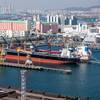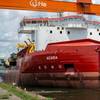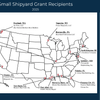The St. Lawrence Seaway opened for the 2001 navigation season on Friday, March 23, 2001, the earliest start in the 43-year history of the waterway that connects the middle of North America with the Atlantic Ocean. "The outlook is good for the St. Lawrence Seaway in the 2001 navigation year," said Guy Veronneau, president of Canadian St. Lawrence Seaway Management Corp.
"Regardless of the softening of the North American economy, goods still need to be moved, and marine transportation remains the most cost-competitive and environmentally friendly way to do so," he added.
Despite a late winter storm that hit the Seaway nexus of Montreal with heavy snow and freezing temperatures this week, Seaway officials complied with requests from shippers for an early start to the season, clearing some sections with icebreakers.
The first ship of the year, the M/T Petrolia Desgagnes, passed through the St. Lambert Lock on the St. Lawrence River on Friday morning on a fuel-delivery run from St.-Romuald, Quebec, to Morrisburg, Ontario.
This season, the Seaway, which provides 24-hour navigation, has introduced a new identification system to make navigation safer and more efficient. All commercial vessels must be fitted with an automatic identification system that uses satellite-based, global positioning system technology to pinpoint their location, speed and heading. The system will flash messages to ships' captains on wind speed and direction, water levels and ice conditions, the Seaway said.
Last year, low water levels in the Great Lakes contributed to a decline in traffic through the system, which includes 13 locks in Canada and two in the United States. During the 275 days the Seaway was open in 2000 -- March 27 to Dec. 26 -- estimated cargo passing through the Welland Canal and the Montreal/Lake Ontario sections of the system was 46 million tons, 1.4 percent lower than 1999. While shipments of imported steel increased last year, grain shipments were lower. Seaway officials said on Friday they expect the number of cruise ship voyages through the waterway to more than double this year, transporting about 14,000 passengers. - (Reuters)
Sponsored Content
Safer Starts Here: Build Ships, Protect Crews

Featured videos

Meet the Volvo Penta IPS Electric (E)

Efficient Maritime Operations Transcend Data; Intelligence is Key

Maritime Energy Transition: Cummins Focuses on Methanol
July 2025
 Read the Magazine
Read the Magazine

 Read the Magazine
Read the Magazine
This issue sponsored by:

Deep Strike: Seabed Warfare Will Target More Than Cables and Pipelines
Subscribe for
Maritime Reporter E-News
Maritime Reporter E-News is the maritime industry's largest circulation and most authoritative ENews Service, delivered to your Email five times per week







